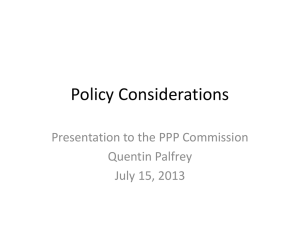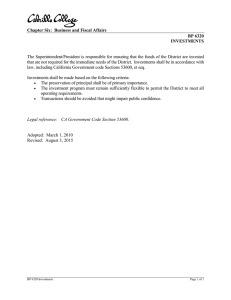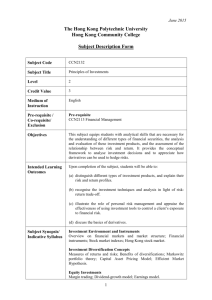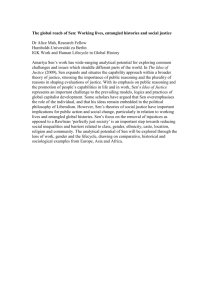+ Human Capital Nabylah Abo dehman Growth Economics
advertisement
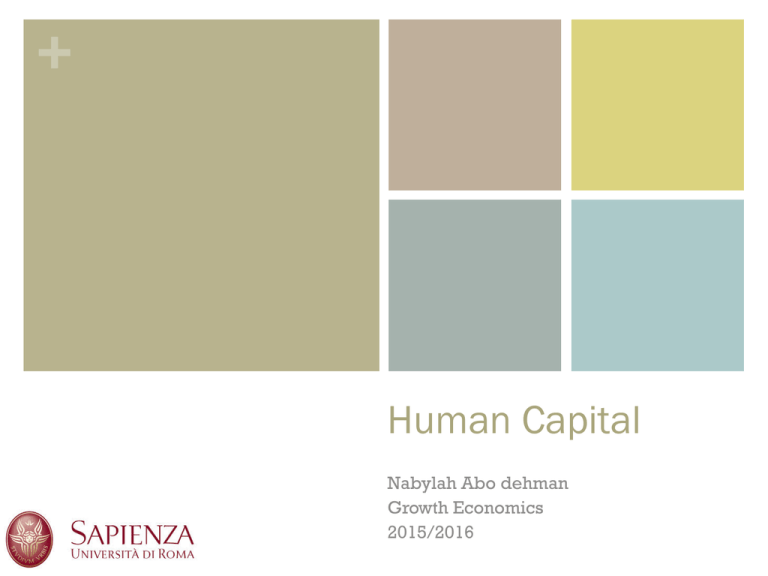
+ Human Capital Nabylah Abo dehman Growth Economics 2015/2016 + Definition Human Capital is a complex theoretical concept that is not defined in a uniform manner à In its most general form, it refers to the resources in people OECD definition: “The knowledge, skills, competences and other attributes embodied in an individual that are relevant to economic activity” à Broad definition as it is not restricted to education but encompasses all investments in human which are made to improve their skills + Definition II n HC as a set of marketable skills of workers thought of as a form of capital in which workers make a variety of investments n HC as any stock of knowledge or characteristics the worker has (either innate or acquired) that contributes to his/her “productivity” + From the labor factor of production to human capital Growth theories have failed for a long time to acknowledge human capital à For neoclassical thinkers, the contribution of the labor factor to the production of wealth was only considered quantitatively (ex. CobbDouglas function) à Labor is apprehended only through the increase of the active population and human behavior is considered to have only a marginal impact on growth à Labor is seen as a homogenous factor (as workers are for the most part non qualified) à BUT form the 50s, this view is challenged by various economists who underline its limitations à As technical progress accelerates and the production cycle gets more complex, the need for an ever greater number of qualified workers emerges with strenght + Contributions to HC theory T. W. Schultz à He insists in particular on the importance of the agricultural sector in development and attributes a key role to human capital à He sees in education and training of individuals essential means to improve productivity and output but also a great way to foster innovation à In Investment in Human Capital (1961) he attempts to clarify human capital measurement by concentrating on the qualitative dimension of labor, that is on “the skills, the knowledge and all the capacities that can improve the productivity of human work” + Contributions to HC theory T. W. Schultz à He distinguishes 5 sources of HC production and improvement 1) Healthcare infrastructure and services that affect life expectancy and human vitality 2) Companies’ sponsored professional training 3) Primary and secondary level education 4) Non-companies’ sponsored study and training programs 5) Migration of individuals and families to seize employment opportunities + Contributions to HC theory T. W. Schultz à His work allowed to better measure the relationship between investments in these five areas and the increase of human capital à He thus contradicted the then currently dominant growth models of Harrod Domar and Solow that linked growth to physical capital accumulation only à To him, there was no doubt that investments that improved peoples’ capacities would impact economic growth positively and that the failure to take human capital into account made economic growth analysis irrelevant and biaised à He also understood that progress in healthcare and education were key variables in explaining economic growth in the 20th century + Contributions to HC theory Gary Becker à He contributed to opening up economics to fields of research traditionally associated with sociology: education and training, racial discrimination, mechanisms of political pressure, criminology and deviant behaviors… à In Human Capital (1964): each worker has his/her own capital that results from his/her innate, given capacities and from his/her education and training à This stock of immaterial (non-physical) capital can increase but also be depleted or become obsolete à It can increase when the individual invests in it à determining differences in productivity and hypothetically affecting differences in revenue + Contributions to HC theory Gary Becker à As with every other investment, we can calculate a marginal rate of return, associated to an expense or to an extra year of study. à The return can be evaluated as the ratio between: On the one hand: the increased return (increased revenue/wage) that this investment will most likely bring in future work activities On the other hand of the totality of the relative costs associated with this investment (school fee etc. but also the wage that the worker will not be making during the time spent investing on education or training). The latter are called “opportunity costs” à Maintaining considered his/her physical capital (health, food, exercise…) should also be à Accumulated knowledge and health are thus to be considered as proper investments alongside other more typical forms of investments + Contributions to HC theory Gary Becker à Human capital is thus an asset, a patrimony, a stock likely to yield returns à It is a stock of knowledge and experiences accumulated by its owner along his/her life thanks to a series of investments à The human capital owners can thus rent their human capital to the owners of physical capital (infrastructures, machinery etc.) as the latter need it because human capital permits the appreciation of physical capital + Impacts of Human Capital • Individual: Ø Much possibility of increasing individual income, resulting from the individual productivity Ø Worker‟s • possibility to move to higher level in the internal market Organization: Ø Collective competences, organizational routines, company culture; and relational capital • Society: Ø Increase of social consciousness of constituents within community Ø Increase of levels of economic growth + HC, growth and development Sen’s capability approach The capability approach is a theoretical framework that entails two core normative claims: 1) freedom to achieve well-being is of primary moral importance 2) freedom to achieve well-being is to be understood in terms of people's capabilities, that is, their real opportunities to do and be what they have reason to value The approach has been developed in a variety of more specific normative theories, such as (partial) theories of social justice or accounts of development ethics It has also led to a new and highly interdisciplinary literature in the social sciences resulting in new statistics and social indicators, and to a new policy paradigm which is mainly used in development studies, the so-called ‘human development approach’ + HC, growth and development Sen’s capability approach it is generally understood as a conceptual framework for a range of normative exercises, including most prominent the following 1) the assessment of individual well-being 2) the evaluation and assessment of social arrangements 3) the design of policies and proposals about social change in society In all these normative exercises, the capability approach prioritizes certain of peoples' beings and doings and their opportunities to realize those beings and doings (such as their genuine opportunities to be educated, their ability to move around or to enjoy supportive social relationships) This stands in contrast to other accounts of well-being, which focus exclusively on subjective categories (such as happiness) or on the material means to well-being (such as resources like income or wealth) + HC, growth and development Sen’s capability approach à Sen suggests seeing the capabilities approach as an enlargement of the theory of human capital à It is about taking into account the role of education in an approach that goes beyond the mere consideration of the latter with regards to the labor market à Capabilities determine the access to other markets such as housing and healthcare à It regards education in terms of the power that the individual holds over his/her own life à This perspective seems better adapted to development economics than existing education theories that are rather concerned with human capital investments , labor market dynamics and/or the management of educational systems + HC, growth and development Sen’s capability approach à In a number of countries, restrictions on social mobility and on freedom more generally can be quite important à this often translates in a fall in return of human capital à The introduction of the evaluation of freedom of choice levels allows to better differentiate between countries and to bring forward appropriate solutions for each à As such it constitutes a fondamental input in the analysis of development issues + HC, growth and development Sen’s capability approach à Alongside material wealth, Sen takes into account all the possibilities offered to the individual (in the economic, social and political fields) that are directly tied to his/her wealth, education level, life expectancy or the possibility to have his/her voice heard in local or national debates à In this view, democracy becomes central: the question is not to figure whether it produces – or not – economic growth BUT rather to assert that it is more relevant in fostering the kind of development that takes individual aspirations into consideration
